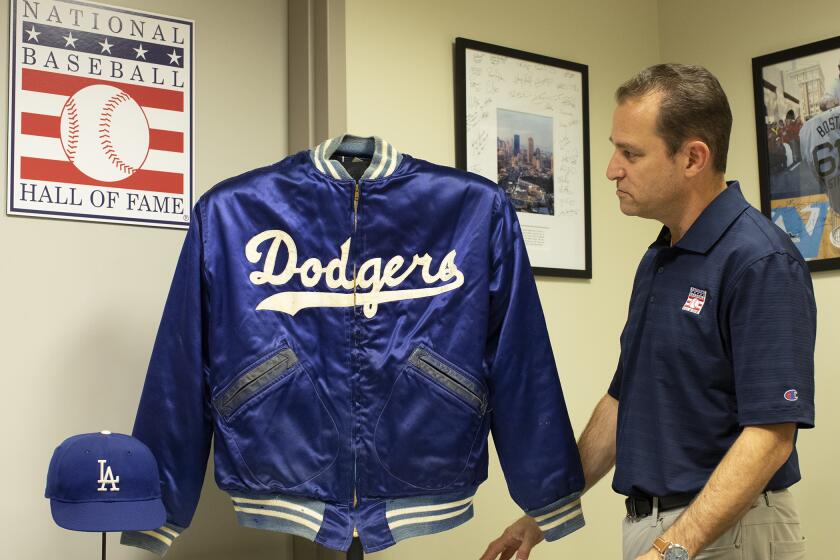Another Blob Story Not to Be Believed
- Share via
One of the things that constantly amazes me about life is the way misconceptions go ringing down the corridors of time from gossip to gossip till they assume the identity of reality, of gospel.
They’re harder to shake than a poor relative. Pity the poor sucker who gets stuck with one of them. He wears it for life like a tattoo.
I call them blobs. They have a life of their own. They grow even if you try to cut off their heads. They’re ineradicable.
The late, great race writer, Joe Palmer, once said: “The next best thing to a lie is the truth nobody will believe.” Well, the next best thing to the truth is a lie everybody believes.
I ran into this one particular blob some time ago. It was at a cocktail party. Some over-served devotee undertook to share his baseball wisdom with me. “It’s well known that the Dodgers ruined Fernando Valenzuela by overworking him on the mound,” he began.
Since this guy didn’t know the infield-fly rule from an insecticide, I let the remark pass. That’s dangerous to do with blobs. The next thing you know, they’ve covered the country.
Some people don’t really want to know. They prefer their certitudes, no matter how shakily based. But the truth of the matter is, Fernando Valenzuela was no more overused than any other good pitcher in the history of the game. And he was used a good deal less than many of them.
Let us compare, for instance, Fernando’s statistics with those of a Dodger pitcher of a generation ago, another star of the staff, Don Drysdale, in their comparative heydays. We get the following chart (games, innings pitched, games started, complete games):
DON DRYSDALE
Year G IP GS CG 1962 43 314 1/3 41 19 1963 42 315 1/3 42 17 1964 40 321 1/3 40 21 1965 44 308 1/3 42 20 1966 40 273 2/3 40 11 1967 38 282 38 9
FERNANDO VALENZUELA
Year G IP GS CG 1982 37 285 37 18 1983 35 257 35 9 1984 34 261 34 12 1985 35 272 1/3 35 14 1986 34 269 1/3 34 20 1987 34 251 34 12
Who was overworked?
If you want to go back in time, you will find that the great Walter Johnson pitched the following inning-totals in his best years: 373, 368, 371 2/3, 371, 346. He pitched 277 innings when he was an old man.
How about Grover Cleveland Alexander? He led the league in innings pitched seven times with totals of 367, 310 1/3, 355, 376 1/3, 388 2/3, 381 2/3 and 363 1/3. He lasted 20 years--with time out for war--and won 373 games, some of them sober. He started 45 games in 1916, completed 38 and won 33. And probably never soaked his arm in ice or ultra-sonic baths.
The immortal Cy Young, who won 511 games, pitched 453 innings one season.
You want someone more contemporary?
How about Tom Terrific? Tom Seaver in his salad years with the Mets pitched 291 innings in 1970, 290 innings in 1973 and 280 in ’75. Ferguson Jenkins had years of 328 innings, 325, 313, 311 and 308.
It is claimed that a screwball, Valenzuela’s money pitch, is hard on the arm. Well, Carl Hubbell who practically invented the pitch, used to pitch so often he was nicknamed the Meal Ticket. He had innings pitched totals of 308 2/3, 313, 302 and 304 in his great years. He lasted 16, even though his left arm looked like something you could open wine with.
It’s possible to overwork a young pitcher. Dizzy Dean was always held up as the classic example of the overused star. He pitched in 50 or more games three years in a row--and had seasons of 324 1/3, 315, and 311 innings--but the telltale stat here is, Dizzy would start in, like 34 or 36 games, but pitch in 50 or more.
In 1936, for instance, Diz started 34 games but pitched in 51. This meant that he had to warm up and pitch in relief 17 times between starts. Now that, you have to say, is overwork. But you will notice in the above charts that Fernando started every game he pitched in and had no appearances between starts.
The notion that Fernando’s troubles stemmed from overwork is a blob. This won’t kill it. Blobs are like nuclear waste. You can’t get rid of them.
You just don’t have to believe them.
More to Read
Are you a true-blue fan?
Get our Dodgers Dugout newsletter for insights, news and much more.
You may occasionally receive promotional content from the Los Angeles Times.









